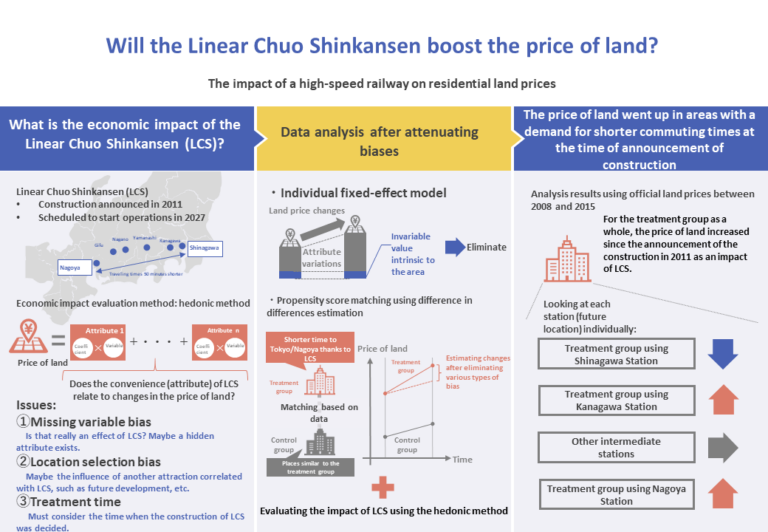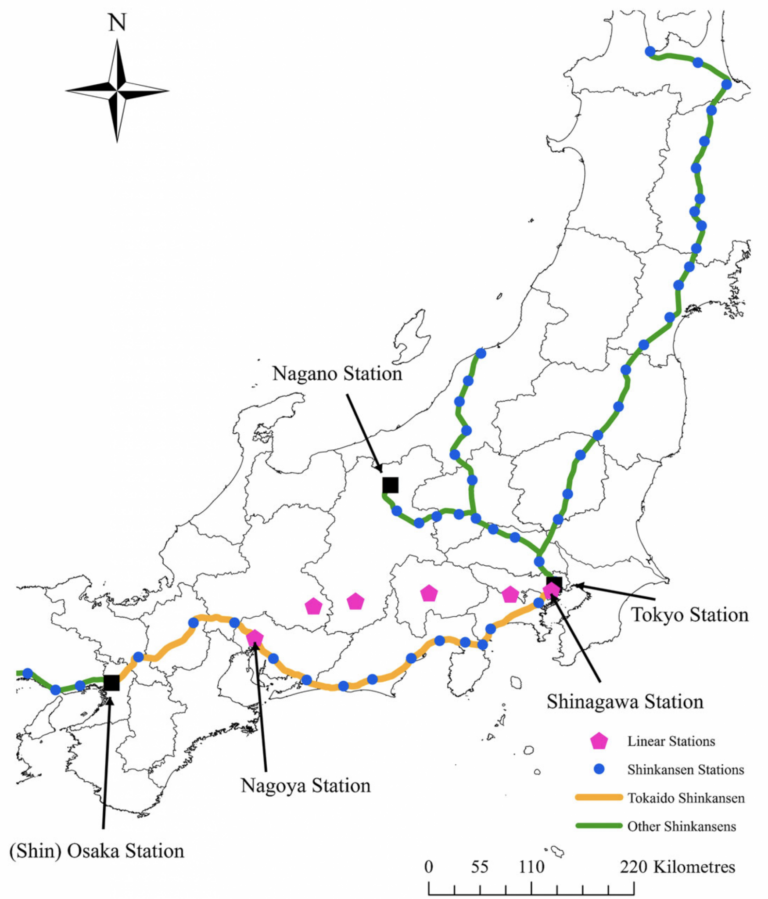Abstract

Background and issues
High-speed railways bring benefits to society by transporting large numbers of people and shortening the time traveling time between cities. However, since construction costs are high, policy makers must be sure that the investment is justified.
In the present research we consider the Linear Chuo Shinkansen (LCS), and investigate whether the benefits of a high-speed railway are reflected in residential land prices. The LCS, run by the Central Japan Railway Company, is scheduled to start operations in 2027 between Shinagawa, in Tokyo, and Nagoya, in Aichi Prefecture. The Ministry of Land, Infrastructure, Transport and Tourism approved the LCS construction plan in May, 2011 (Figure 1).

The hedonic method seeks to assess the value of the environment, based on the idea that the price of goods can be explained by the attributes that compose it, considering how differences in environmental conditions are reflected in the price of land. It is a widely-used method of evaluating the overall economic impact of railways.
However, the following estimation problems occur when evaluating the impact on the price of land of the development of transportation infrastructure.
The first problem is missing variable bias. Land has numerous unmeasurable attributes that often exhibit mutual correlations or are correlated with treatment variables. Therefore, the value predicted by the hedonic method is often biased.
The second problem is location selection bias. Transportation infrastructure is in general constructed in locations where the number of users will be large. Therefore, the measured impact includes the effect of location selection (future development, etc.).
The third problem is treatment time. In order to assess the increase in asset values, it is necessary to consider the time when the decision was made to execute the construction work. The rise in asset value occurs when it becomes clear that the service will commence in the future.
In the present research, using residential land price panel data from 2008 to 2015 and traveling times to large cities, we show solutions to estimation problems, and problems with the definition of treatment groups. We evaluate the impact of the construction of high-speed railways on land price, and then measure the imbalance of the impact of railway construction. We also clarify the point in time when the benefits of high-speed railways are capitalized as land price assets.
In developed countries there is limited experimental proof showing the value of high-speed railways. In the present research, we provide a valuable proof of the economic value of high-speed railways. Moreover, the benefits brought by high-speed railways may differ considerably from region to region. That knowledge provides an important basis for local communities to make decisions concerning high-speed railways.
Data analysis
Using official land prices from 2008 to 2015, we investigated whether the benefits of LCS were capitalized as residential land prices from 2011 onwards. Since official land prices are published on January 1st every year, they are structured as panel data.
In these panel data, unmeasurable missing variables with no time variations can be controlled by means of individual fixed effects. In addition, since official land prices are evaluated by specialists, measurement errors are smaller compared to other data.
Here, we define the treatment group as the points for which the traveling time to Tokyo or Nagoya stations will be reduced by the use of LCS, compared to now. For this purpose, information is required on traveling times from each surveyed point to city train stations, in cases when LCS is used and when it is not used.
For the case when LCS is not used, the traveling time to Tokyo or Nagoya stations is obtained as the sum of the shortest time from the surveyed point to the closest local line station and the shortest traveling time from the closest local line station to Tokyo or Nagoya station using existing means of transportation.
The traveling time to the LCS stations in the case when LCS is used is calculated as follows.
First, we explain how to obtain the traveling time to the final station. In the treatment group pertaining to Nagoya station, one boards the LCS at Nagoya station and transfers to a local line at Shinagawa station. Then, the traveling time to Tokyo station is defined as the sum of the traveling time from the surveyed point to Nagoya station, and the traveling time from Nagoya to Tokyo station, using LCS and a local line.
On the other hand, regarding the treatment group pertaining to Shinagawa station, since Shinagawa station is close to Tokyo station, the traveling time is defined as the sum of the traveling time from the surveyed point to Shinagawa station, passing through Tokyo, and the traveling time from Shinagawa station to Nagoya station using LCS.
As a second point, we explain how to calculate the traveling time to an intermediate station. The traveling time from a treatment group pertaining to an intermediate station to Tokyo or Nagoya station is defined as the sum of the traveling time by car from the surveyed point to the closest intermediate station, and the traveling time from the intermediate station to Tokyo or Nagoya station.
Using propensity score matching and the attributes of the nearby environment, we selected control groups exhibiting the same land market conditions as the treatment group. For propensity score estimation, we used official land price information as of 2011, the 2010 Census, and the 2006 Economic Census for Business Frame.
In the present research, we control time-invariant factors by using individual fixed effect models and balanced individual panel data. Moreover, propensity score matching based on a difference in differences estimation (MDID) is used, in order to deal with missing variables that exhibit time variations. Selection bias is reduced by applying MDID in every estimation. By using propensity score matching and defining control groups similar to treatment groups, it is possible to alleviate the place selection problem.
Evaluation and tests
In the first place, the average treatment effect on the treated (ATT) of LCS on residential land price for the entire treatment group was approximately 0.5%. This result suggests that the benefits of LCS were capitalized in terms of discounted present value just after the construction plan was disclosed.
Next, we will discuss ATT regarding each railway station. The effect in terms of residential land prices in the treatment group pertaining to Shinagawa station was 3.26%. However, the land price increase after controlling location selection bias was -0.44% to -0.55%. The benefits of the treatment group pertaining to Shinagawa station consist in shortening traveling times to destinations in the Nagoya area, or further to the west. This result suggests that the benefits are not capitalized in terms of residential land prices, perhaps because of Tokyo’s overcrowding.
On the other hand, the average treatment effect for the treatment group pertaining to the other final station, Nagoya, is 1.73% to 1.87% even after controlling location selection bias. In other words, the benefits of shortening traveling times to the Metropolitan areas are capitalized in the land prices of those regions. Shortening traveling times connecting areas of small economic scale to areas of large economic scale result in an increase in land price.
However, the ATT for treatment groups pertaining to intermediate stations is small. An increase in land prices was observed only in the treatment group pertaining to Kanagawa station (approximately 1.00% to 1.43%). Treatment groups pertaining to other intermediate stations have a low demographic density, a high proportion of elderly people, and decreasing populations. Even though traveling times to main cities were significantly reduced, these areas were not selected as residential areas because other utilities related to the consumption of goods were small.
Finally, we examine whether increases in land price depend on distances to each station.
The treatment group pertaining to Shinagawa station is large, and ATT turns negative in a statistically significant way from a distance of 50 km and further. The average traveling time to Tokyo station from a treatment group located 50 km or more from Shinagawa station is 131 minutes. This traveling time is longer than the shortest traveling time from Nagoya station to Shinagawa station when using LCS (40 minutes). Moreover, the shortest traveling time from Nagoya station to Shinagawa station is approximately 100 minutes. The demand for land in this area may be moving towards the Nagoya area.
On the other hand, land prices in the treatment group located within 100 km from Nagoya station are rising, and the rise within 20 km is large. This fact suggests that indirect effects of LCS, such as expectations of public urban development and private company mergers, are high in the surroundings of Nagoya station.
As for intermediate stations, a statistically significant rise in land prices was observed only in treatment groups within 50 km from a station in Kanagawa Prefecture. This fact explains why only one train per hour stops in these intermediate stations.
Results and proposal
In the present research we investigated whether the benefits to be brought by the construction of the LCS, expected to start operations in 2027, were capitalized in land prices soon after the announcement of the decision to carry out the construction. We observed that residential land prices have increased in areas where the traveling time to the Metropolitan region will be shortened, except in regions with decreasing populations. This suggests that in cases where there is a demand for shorter traveling times, the benefit tends to be capitalized in land prices soon after the information is disclosed.
It was shown in the present research that sample selection bias may occur during the evaluation of impact if samples are spatially concentrated, even if locations are selected by means of geographical experiments. Moreover, the obtained insights suggest the difficulty in interpreting estimated results without considering the starting times of the treatment.


